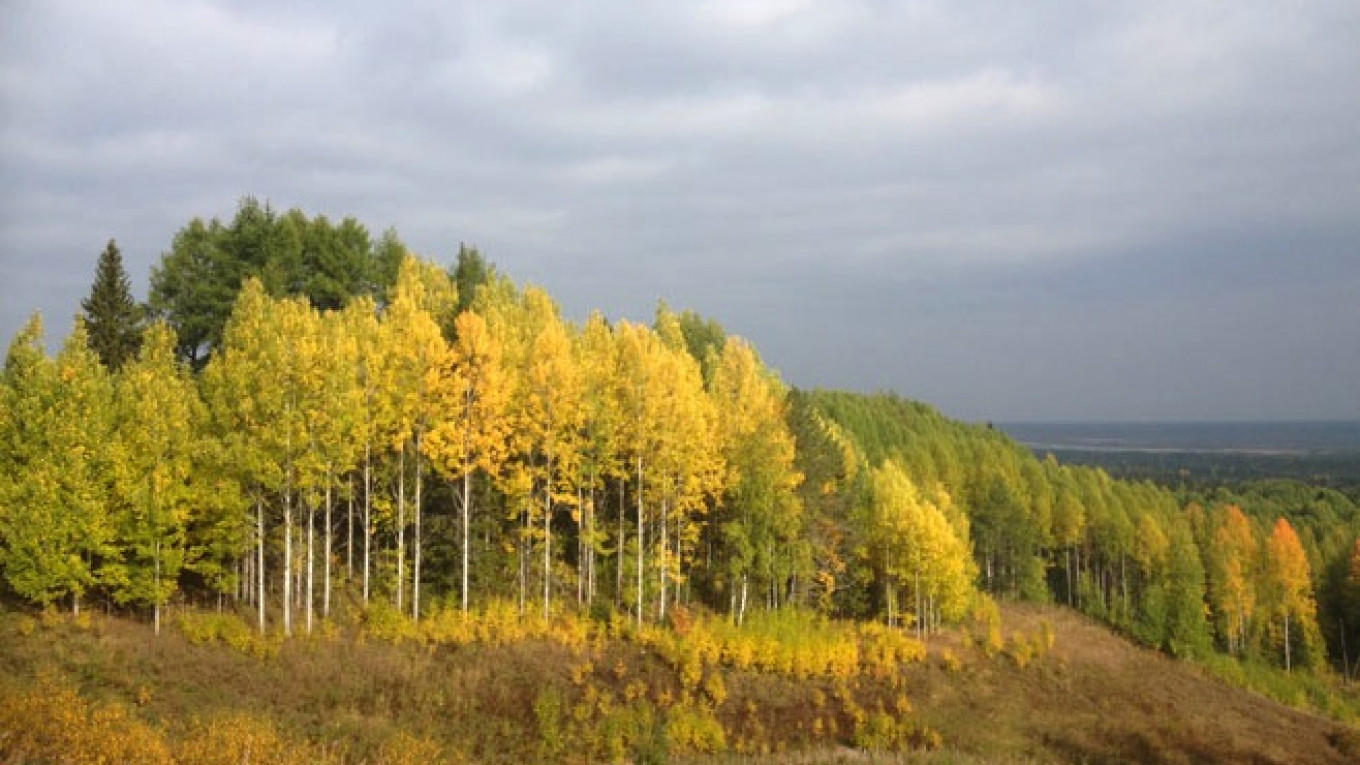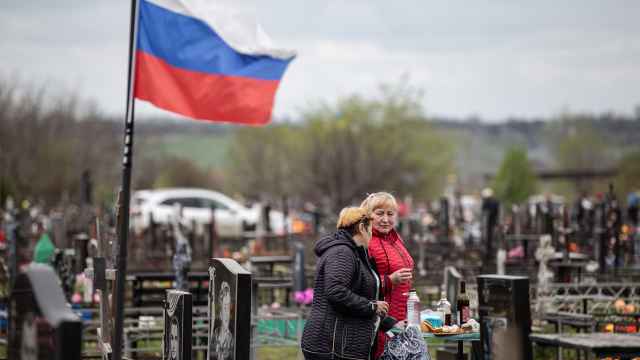In the beginning, Europe was forest country. Most of it is long gone, but a touch of the old world still survives in the Russian north.
A case in point is the Pinezhsky wildlife reserve in the Arkhangelsk region, a protected chunk of Europe's biggest extant massifs of virgin forests, which have never been logged in human history.
The Pinezhsky reserve is mostly quiet during the Indian summer. The birds are long done with mating songs and are preparing to fly south. The orchids — of which there are 26 species here — are also finished tricking insects with morphine and imitation of mating partners and are dormant. Not even the local chipmunk shows up on the tourist trail, despite his well documented interest in people.
Bats are asleep in the karst (limestone landscape) area's dozens of caves, where the cave custodian — a sturdy limping man with a dwarf's gait and a wizard's voice — is keen to point them out to the last of this year's 10,000 annual tourists.
But the woodpeckers and ravens are still busy, and the ground is blanketed with berries and edible mushrooms (and the occasional toadstool) under sentry-like fir trees and birches blazing a blinding yellow in the sun on the hills and above the occasional waterfall, giving the area a fairytale look.
The primeval idyll ends a kilometer from there, on logging grounds by a gas station, where stacks of planks span as far as the eye can see, ready to be shipped out from a region once known as the "All-Union Lumber Mill."
Only a fraction of the virgin forests in the Russian north are protected, the rest receding and fragmenting amid logging and the rising mining industry.
More territories are slated for conservation, but not nearly enough to meet Russia's international obligations to have 17 percent of its land territory under protection.
And even increasing protected zones does not guarantee the survival of virgin forests, given the trend throughout the "Barents Euro-Arctic Region" — abbreviated, fittingly, to BEAR and comprising a mega-ecosystem network spanning the northernmost provinces of Russia, Finland, Norway and Sweden — to only protect areas with minimum economic value such as tundra, environmentalists say.
"All too many people see a forest as a log deposit to be mined and abandoned," said Artyom Stolpovsky, an independent environmentalist in Arkhangelsk working with the WWF Russia.
BEAR Stripped Bare
Though only 3 percent of Europe's original woodland cover survives to this day, according to a Greenpeace study from 2006, virgin forests are still found in Britain, Finland, Montenegro, Norway, Poland and Slovakia.
However, most of those are too small for their ecosystems to maintain the original level of biodiversity, said Denis Dobrynin of the WWF Russia's Barents branch.
Only the Russian north is home to virgin forests big enough and as untouched by fragmentation to be essentially pre-human forests, Dobrynin told a conference of journalists and experts at the Pinezhsky reserve last week.
In the Arkhangelsk region, virgin forests amount to some 90,000 square kilometers of a total forest area roughly the size of Germany or Italy: 300,000 square kilometers. The Pinezhsky reserve is a modest 500 square kilometers in size.
In absolute figures, Russia has the biggest nature reserves in BEAR of all four countries. But they only amount to some 11 percent of the Russian part of BEAR, compared with 15 percent in Norway, 22 percent in Sweden and 24 percent in Finland, according to a study presented last summer by Transparent World, a Moscow-based environmental NGO.
The strategic goals of the UN Convention on Biological Diversity, ratified by Russia in 1995, require signatories to set aside 17 percent of their land for environmental protection by 2020.
But while Norway looks set to reach the goal of 17 percent, Russia's existing expansion plans will only put 14.5 percent of its portion of BEAR under protection, according to Transparent World's calculations.
This is despite the fact that the creation of nature reserves is much easier in Russia — where all land is state-owned — than in Scandinavia, where much of the territory is privately or municipally owned, said Dmitry Aksyonov, a veteran environmentalist who heads Transparent World.
The situation is less than rosy in the Nordic countries as well: Throughout BEAR, there is unprotected taiga and other economically valuable forest, despite the impressive overall size of the protected area, according to Transparent World.
About 40 percent of BEAR's polar deserts and mountain tundras are under protection, but no type of forest, according to the NGO, has a level close to 17 percent — a figure that, environmentalist Stolpovsky said, is in itself also too low to ensure the preservation of fragile northern ecosystems.
To Russia's credit, it is the only BEAR country to have vast nature reserves with a strict no-access policy that negates human impact on the environment (in the Pinezhsky reserve, only the buffer perimeter zone of several kilometers is accessible to tourists and local hunters and berry-pickers).
But even the country's top officials fail to recognize — let alone develop — this policy, with Prime Minister Dmitry Medvedev repeatedly advocating tourism in closed reserves as he applies the Russian government's overall strategy of commercializing spheres of public life, including education, health care and environmental protection.
Loggers & Bureaucrats
Russia lost between 8 and 10 percent of its virgin forests between 2000 and 2013, according to Transparent World. In Arkhangelsk, that figure was 15 percent.
Manmade fires are the prime culprit, accounting for 60 percent of forests lost or fragmented across the country. Logging was the second biggest factor, responsible for 24 percent of lost forest, followed by mining at 16 percent.
Loggers can be reasoned with, because most Arkhangelsk timber is exported to Europe and as such, has to obtain certification from the global body Forest Stewardship Council (FSC), which includes environmental requirements, said activist Stolpovsky, who acts as something of a rogue forest warden, roaming the Arkhangelsk region harassing loggers with complains and exposés.
The region's leading timber industry players have consented to a legally non-binding "gentlemen's agreement" endorsing the creation of new nature reserves in the region, said the WWF's Dobrynin.
This is a considerable concession because it depletes the forest reserves the companies have on lease, and the loggers remain jittery about possible further expansion.
"These people pay their taxes here," said Yelena Rai, an expert on northern orchids who also works as a consultant for companies looking for FSC certification.
"They just need stability," Rai told The Moscow Times on the sidelines of the Pinezhsky conference, speaking in hushed tones so as not to trigger any remonstration from environmental warriors.
But the main problem is the federal authorities, who, in Stolpovsky's description, "have stocked up on popcorn and watch us fight it out with the loggers."
All plans to create new wildlife reserves have been stalled for years in the bureaucratic limbo of the understaffed Natural Resources and Ecology Ministry in Moscow, which, controversially, simultaneously oversees the conflicting businesses of natural resources extraction and wildlife conservation.
If the bureaucratic stalemate persists, the loggers may just go back on their promises and resume the destruction of virgin forests, Dobrynin said.
The Russian timber industry is plagued by microscopic profit margins, not least because the country is slowly running out of forests located conveniently enough to make it possible to recoup the costs of transporting timber across vast spans of rough, roadless terrain.
The few years' worth of chairs and chalk paper produced as a result of resumed deforestation in the pristine woodland of the Far North will soon be used up and forgotten, but the consequences will reverberate long after our generation is gone and forgotten, Stolpovsky said.
"It takes from 900 to 1,000 years for a forest like this to fully re-emerge once it is destroyed," he said, looking around at the yellow birches and deep green firs of the Pinezhsky reserve.
This article has been amended to include the correct figure for the size of virgin forests in Arkhangelsk as 90,000 square kilometers rather than 50,000 square kilometers in the original version.
A Message from The Moscow Times:
Dear readers,
We are facing unprecedented challenges. Russia's Prosecutor General's Office has designated The Moscow Times as an "undesirable" organization, criminalizing our work and putting our staff at risk of prosecution. This follows our earlier unjust labeling as a "foreign agent."
These actions are direct attempts to silence independent journalism in Russia. The authorities claim our work "discredits the decisions of the Russian leadership." We see things differently: we strive to provide accurate, unbiased reporting on Russia.
We, the journalists of The Moscow Times, refuse to be silenced. But to continue our work, we need your help.
Your support, no matter how small, makes a world of difference. If you can, please support us monthly starting from just $2. It's quick to set up, and every contribution makes a significant impact.
By supporting The Moscow Times, you're defending open, independent journalism in the face of repression. Thank you for standing with us.
Remind me later.







